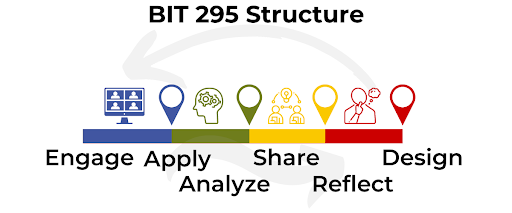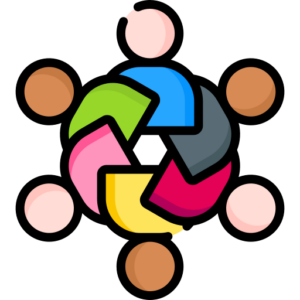By Carly Sjogren, B.A., Ph.D., Education Postdoc in the Biotechnology Program at NC State
I have seen my fair share of students disinterested in the content of biology courses over the past decade. My joy for sharing the beauty of gene expression, for example, does not persuade incoming STEM majors that they belong in science, just as much as me watching a National Geographic special on Jane Goodall does not persuade me to go live in the jungle. Even if you enjoy watching a passionate scientist doing what she loves, for many college students, belonging in science is beyond their lived experiences and looks intimidating and uncomfortable. How can educators reinvigorate the classroom with the joy and curiosity of using the scientific method in a way that authentically values and integrates our students’ identities?
Engaged pedagogies that include active learning (2, 3), Ungrading (4), scientific teaching (5) and universal design for learning (6) have all been amazingly transformative to break down barriers and increase diversity in STEM. Open Pedagogy embraces collaboration and student agency providing students the opportunity to create resources that reaches beyond the purpose of the course gradebook (*). This Spring 2022 semester I co-taught NCSU BIT 295 Biotechnology & Sustainability with Dr. Carlos Goller (7). Let me share what I have learned from this course that is grounded in Open Pedagogy (8). Here are five aspects of the course and the takeaways I have learned sharing specific examples you can adopt in your courses.

Course Information & Promoting Inclusivity
Biotechnology & Sustainability is a 3-unit introductory science Course-based Undergraduate Research Experience (CURE) (9) for first and second year students. Our goals for this course are to introduce students to genetics, bioinformatics and microbiology through the question of how to solve a real world problem: Can microbiology be used to sustainably recycle electronic waste? Dr. Goller and I teach by proudly placing high value on inclusivity, emphasizing that without diverse scientists, we do inferior science.
- Takeaway: Promote inclusivity often in course materials & learning activities.
- Examples:
- Broadcast your inclusive values early with a Welcome message in the Syllabus (link).
- Foster a sense of collaboration with an Getting Started Moodle assignment or an FDOC activity using Community Guidelines (link). Then collaborate often!
- Send encouraging communications weekly to help keep students on track and motivate them (link).
Promoting Science Identity: Using science to solve problems
People who are scientists practice using the Scientific Method to solve problems. Many “non-science” jobs require “problem-solving” on the list of required skills and our students need to gain these skills. Start using the scientific method in your courses by designing one new lesson that gets students to practice solving problems with the scientific method.
- Takeaway: Remind students that scientists use the scientific method to solve problems, and point out how they are using it too!
- Examples:
- Make a custom H5P Book on Moodle to engage students in the research step of the Scientific Method (link).
- Use a collaborative annotation tool like Hypothes.is (link) to help support novice learners to read primary literature.
- Find a case study for a lecture activity, like the one we use from Dr. Adam Simon (link).
Designing open assignments that give students choices and integrate their identity
It can be powerful for us to give all students opportunities to explore their lived experiences that shape their development of identity. Giving students options to complete assignments allows for them to gain a sense of autonomy, and also boosts your course accessibility from a Universal Design for Learning framework (6).

- Takeaway: Give students options for completing assignments in ways that incorporate their identity and that are renewable.
- Examples:
- Make writing assignments with multiple prompts for students to choose from, like our Ethical Reasoning Case Studies. Students complete 5 of the 10 options provided and their responses include their unique perspectives (link).
- Make a course project that will be communicated with the general public in their hometown, like our Public Science Project (link).
- Create a weekly reflection where students can write about how the information they just learned impacts their academic goals and how they can share their new knowledge with their communities.
Incorporating interdisciplinary approaches
The future of science is collaborative and we can promote working with scientists who have different specialties to tackle problems. Science is strengthened by bringing groups of diverse people together to solve problems.
- Takeaway: Normalize that no individual needs to hold all the answers, and that science is people powered.
- Examples:
- Invite guest speakers to your class to share their work. If that does not fit in your course schedule, start a class by talking about the people who worked on that topic.
- Strike up a collaboration with another campus and design a project where students from different campuses can peer review each other’s work on the same assignment.
- Foster collaboration as a required part of science through a group project like our Team Project Design Challenge (link).
Instructors who treat students as human beings (with people problems)
Often when a student is falling behind, there is a defeated internal voice telling themselves “You are not good enough.” I’ve gotten much better work from my students when I reassure them that I see them as trying hard, and ask them what support they need to get their task done. Our students will be much more equipped for the workforce if they can communicate to superiors their time management shortages and can adjust with reasonable deadlines.

- Takeaway: Normalize making mistakes and encourage students’ humanity.
- Examples:
- Foster a culture of grace where deadlines are about setting goals, meeting goals, and that for good reason goals can change.
- Start class with a question where you get responses from ALL students so that students can learn from the different perspectives in the room, and also learn that perhaps they are not the only one who makes mistakes.
- Be your authentic self as an example that you can have a unique personality, good days and bad days, and be a full person with people-problems as an example of what a scientist can be (many things).
- All people, including scientists, have biases, can let their personal lives affect their work, and can make mistakes. Train your students to think ethically in the face of a dilemma by incorporating an ethical reasoning case study into a class that is not explicitly advertised as an ethics course (link).
I have shared here some of what I have learned about Open Pedagogy from teaching with Dr. Carlos Goller and I have had a blast! I can’t wait to learn from you next!
References
- Jones, MG, Chesnutt, K, Ennes, M, Mulvey, KL, Cayton, E. Understanding science career aspirations: Factors predicting future science task value. J Res Sci Teach. 2021; 58: 937– 955. https://doi.org/10.1002/tea.21687
- Eddy SL, Hogan KA. Getting under the hood: how and for whom does increasing course structure work? CBE Life Sci Educ. 2014 Fall;13(3):453-68. DOI: 10.1187/cbe.14-03-0050. PMID: 25185229; PMCID: PMC4152207.
- Kimberly D. Tanner. Structure Matters: Twenty-One Teaching Strategies to Promote Student Engagement and Cultivate Classroom Equity CBE—Life Sciences Education 2013 12:3, 322-331
- Kohn, Alfie and Susan D. Blum. Ungrading: Why Rating Students Undermines Learning (and What to Do Instead). First edition. ed. West Virginia University Press, 2020. Project MUSE muse.jhu.edu/book/78367.
- Handelsman, J., Miller, S., Pfund, C., & Wisconsin Program for Scientific Teaching. (2007). Scientific teaching.
- Universal Design for Learning. (Retrieval April 2022). https://udlguidelines.cast.org/
- Carlos Goller. (Retrieval April 2022). https://carloscgollerphd.blog/
- Open Pedagogy at NC State. (Retrieval April 2022). https://www.lib.ncsu.edu/open-pedagogy-nc-state
- Lisa Corwin Auchincloss, Sandra L. Laursen, Janet L. Branchaw, Kevin Eagan, Mark Graham, David I. Hanauer, Gwendolyn Lawrie, Colleen M. McLinn, Nancy Pelaez, Susan Rowland, Marcy Towns, Nancy M. Trautmann, Pratibha Varma-Nelson, Timothy J. Weston, and Erin L. Dolan. Assessment of Course-Based Undergraduate Research Experiences: A Meeting Report. CBE—Life Sciences Education 2014 13:1, 29-40.
*Open Education. https://www.lib.ncsu.edu/do/open-educationOpen Pedagogy at NC State. (Retrieval April 2022). https://www.lib.ncsu.edu/open-pedagogy-nc-state